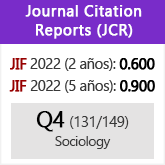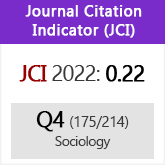Estratificación social y delincuencia. Cuarenta años de discrepancias sociológicas
DOI:
https://doi.org/10.3989/ris.2006.i45.21Palabras clave:
Clase social, Estatus social, Tipos de delincuencia, Auto-informes, Oportunidades ilegítimasResumen
La sociología de la delincuencia encontró en la clase social un robusto e indiscutible apoyo sobre el que sustentarse para explicar los comportamientos desviados. Las bases teóricas fundamentales se cimentaron sobre un puñado de teorías que tuvieron su origen en los años cincuenta del pasado siglo y que se extendieron básicamente durante los treinta años siguientes. Pero esta claridad teórica no acabó de encontrar una apoyatura práctica. Cuando se empezaran a poner en tela de juicio los datos de las estadísticas oficiales procedentes de la policía y de los tribunales y en su lugar se echó mano de los auto-informes, los investigadores se dieron de bruces con una realidad insospechada: la extensa delincuencia de cuello blanco no registrada. Ello indujo a pensar que la relación entre clase social y delincuencia era en realidad un mito sostenido sobre los prejuicios de considerar a una clase social como más peligrosa, detenerla más, juzgarla más y condenarla más. Surgió entonces una prolongada controversia fundamentada sobre dos postulados inamovibles: “no importa cómo se mire la clase social, ya que no incide sobre la delincuencia” frente a “la clase social correlaciona negativamente con la delincuencia; según se baja en la escala aumentan los delitos”.
Descargas
Citas
kers, R. (1964), “Socio-Economic status and delinquent behaviour: a retest”, Journal of Research in Crime and Delinquency, nº 1, pp. 38-46. doi:10.1177/002242786400100105
Ball, R. (1966), “An empirical exploration of neutralization theory”, Criminologica, nº 3, pp. 103-120.
Blishen, B. (1961), “ The construction and use of an occupational class scale”, en B. Blishen et al., (ed), Canadian society, Toronto, MacMillan, pp.1-35.
Bonger, W. (1916), Criminality and economic conditions, Boston, Little Brown.
Bordua, D. (1962), “A critique of sociological interpretations of gang delinquency”, en Wolfgang et al. (Ed.), The sociology of crime and delinquency, Nueva York, John Wiley y Sons.
Box, S. (1981), Deviancy, reality and society, Londres, Rinehart and Winston.
Box, S. (1991), Power, crime and mystification, Londres, Routledge.
Braithwaite, J. (1981), “The myth of social class and criminality reconsidered”, American Sociological Review, nº 46, pp. 36-57. doi:10.2307/2095025
Brownfield, S. (1986), “Social class and violent behaviour”, Criminology, nº. 24, pp. 421-438. doi:10.1111/j.1745-9125.1986.tb00384.x
Brown, S.(1984), “Social class, child maltreatment, and delinquent behaviour”, Criminology, nº 22, pp. 259-278. doi:10.1111/j.1745-9125.1984.tb00300.x
Cernkovich S. y P. Giordano (1979),” A comparative analysis of male and female delinquency”, Sociological Quarterly, nº 20, pp, 131-145.
Cernkovich S. y P. Giordano (1992), “School bonding, age, race, and delinquency”, Criminology, nº 30, pp. 261-291. doi:10.1111/j.1745-9125.1992.tb01105.x
Clark, J. y E. Wenninger (1962), “Socio-economic class and area as correlates of illegal behavior among juveniles”, American Sociological Reviewn, nº 27, pp. 826-834.
Clelland D. y T. Carter (1980), “The new myth of class and crime”, Criminology, nº 18, pp. 319-336. doi:10.1111/j.1745-9125.1980.tb01368.x
Cloward R. y LL. Ohlin (1966), Delinquency and opportunity: a theory of delinquent gangs, Nueva York, The Free Press.
Cohen, A. (1971), Delinquent boys: the culture of the gangs, Nueva York, Free Press.
Cohen, A. K. (1965), “The sociology of the deviant act: anomie theory and beyond”, American Sociological Review, nº 30, pp. 5-14. doi:10.2307/2091770 PMid:14247328
Cohen, S. (1988), Visiones de control social, Barcelona, Promociones y Publicaciones Universitarias.
Coleman J. y J. Moynihan (1996), Understanding crime data: haunted by the dark figure, Buckingham, Opens University Press.
Cullen, F. (1983), Rethinking crime and deviance theory: the emergence of a structuring tradition, Nueva- Jersey, Rowman y Allanheld.
Dentler R. y L. Monroe (1961), “Social correlates of early adolescent theft”, American Sociological Review, nº 26, pp. 733-743. doi:10.2307/2090202
Duncan, O. D. (1961), “A socioeconomic index for all occupations”, en A. Reiss (ed.), Occupations and social status, Nueva York, Free Press.
Elley W. y J. Irving (1976), “Revised socio-economic index for New Zealand”, New Zealand Journal of Educationl Studies, nº 7, pp. 153-167.
Elliot D. y S. Ageton (1980), “Reconciling race and class differences in self- reported and official estimates of delinquency”, American Sociological Review, nº 45, pp. 95-110. doi:10.2307/2095245
Elliot D. y D.Huizinga (1983), “Social class and delinquent behavior in a national youth panel”, Criminology n. 21, pp. 149-177. doi:10.1111/j.1745-9125.1983.tb00256.x
Elliot D. y H. Voss (1974), Delinquency and dropout, Lexington, Lexington Books.
Erikson, M. (1973), “Group violations, socio-economic status and official delinquency”, Social Forces nº 52, pp. 41-52. doi:10.2307/2576422
Farnworth, M. et al. (1994), “Measurement in the study of class and delinquency: integrating theory and research”, Journal of Research in Crime and Delinquency, nº 31, pp. 32-61. doi:10.1177/0022427894031001002
Farrington, D.(1983), Further analyses of a longitudinal survey of crime and delinquency. Final report to the National Institute of Justice, Washington.
Gibbs, L. (1974), ”Effects of juvenile legal procedures on juvenile offenders´ self-attitudes”, Journal of Research in Crime and Delinquency”, nº 11, pp. 52-55.
Gold, M. (1966), “Undetected delinquent behaviour“, Journal of Rresearch in Crime and Delinquency, nº 3, pp. 27-46.
Gordon, R. (1976), “Prevalence : the rare datum in delincuency measurement and its implications for the theory of delincuency“, en W. Malcolm (ed.), The juveline justice system, Sage, Beverly Hills.
Gordon, R., et al. (1963), “Values and gang delinquency: a study of street corner groups”, American Journal of Sociology, nº 69, pp. 109-128. doi:10.1086/223541
Greenberg, D. (ed.) (1977), “Delinquency and the age structure of society“, Contemporary Crises, nº 1, pp. 189- 223. doi:10.1007/BF00728871
Greenberg, D. (1981), Crime and capitalism, California, Mayfeld.
Greenberg, D. (1999), “The weak strength of social control theory”, Crime and delinquency, nº 45, pp. 66-81. doi:10.1177/0011128799045001004
Hagan, J. et al. (1985), “The Class structure of gender and delinquency: toward a power-control theory of common delinquent behavior“, American Journal of Sociology, nº 90, pp.1151- 78. doi:10.1086/228206
Hagan, J. et al. (1987), “Class in the household: a power-control theory of gender and delinquency”, American Journal of Sociology, nº. 92, pp. 788-816. doi:10.1086/228583
Hagan, J. et al. (1990), “Clarifyng and extending power-control theory”, American Journal of Sociology, vol. 95, nº 4, pp. 1024-1037. doi:10.1086/229384
Hagan, J. (1992), “The poverty of a classless criminology“, Criminology, nº 30, pp.1-19. doi:10.1111/j.1745-9125.1992.tb01091.x
Hagell, A. y T. Newburn (1994), “Persistent young offendersª, Londres, Policy Studies Institute.
Hall, P. (1965), Las grandes ciudades y sus problemas, Madrid, Guadarrama.
Hepburn, J. (1977), “The impact of police intervention upon juvenile delinquents“, Criminology, nº 15, pp. 235-262. doi:10.1111/j.1745-9125.1977.tb00064.x
Hernandez De Frutos, T. y E. Casares (2002), Aportaciones teórico- prácticas para el conocimiento de actitudes violentas en el ámbito escolar, Navarra, Fondo de Publicaciones del Gobierno de Navarra.
Hernández De Frutos, T. (2004), “La exclusión urbanística y residencial en España: espacios degradados y viviendas inaccesibles“, en J.F. Tezanos (Ed.), Tendencias en desigualdad y exclusión social, Madrid, Sistema, pp. 683-737.
Hindelang et al. (1979), “Correlates of delinquency: the illusion of discrepancy between self-report and official measures“, American Sociological Review, nº 44, pp. 995-1014. doi:10.2307/2094722
Hindelang et al. (1981), Measuring delinquency, Sage, Beverly Hills.
Hirschi, T. (1969), Causes of delinquency, Berkeley, University of California Press.
Hirschi, T. (1980), “Labelling theory and juvenile delinquency: an assessment of the evidence”, en W. Gove (ed.). The labelling of deviance: evaluating a perspective, Nueva York, Wiley, pp. 181-204.
Hoffman J. y T. Ireland (1994), “Cloward and Ohlin’s strain theory reexamined: an elaborated theoretical model”, en F. Adler y W. Laufer (eds.), Advances in criminological theory, Nueva Jersey, Transaction, pp. 113-137
Hollingshead A. y C. Redlich (1958), Social class and mental illness, Nueva York, Wiley.
Jensen G. y D. Rojek (1980), Delinquency: a sociological view, Lexington, Heath.
Jensen G. y K. Thompson (1990), “What’s class got to do with it? A further examination of power-control theory““ American Journal of Sociology, nº 95, pp. 1009-1023. doi:10.1086/229383
Johnstone, J.(1978), “Social class, social areas and delinquency, Sociology and social research, nº 63, pp. 49-72
Matsueda, R. (1992), “Reflected appraisals, parental labeling, and delinquency: specifying a symbolic interactionist theory”, American Journal od Sociology, vol. 97, nº 6, pp.1577-1611
Mclaughlin E. y J. Muncie (2001), Controlling crime, Londres, Open University.
Menard, S. (1992), “Demographic and theoretical variables in the age-period-cohort analysis of illegal behavior“, Journal of Research in Crime and Delinquency, nº 29, pp. 178-1999. doi:10.1177/0022427892029002005
Merton, R. (1978), “Estructura social y anomia: revisión y ampliación”, en E. Fromm et al. (ed.), La familia. Barcelona, Península, pp. 67-107.
Miller, W. (1958), “Lower class culture as a generating milieu of gang delinquency”, Journal of Social Issues, nº 14, pp. 5-19.
Minor, W. (1980), “The neutralization of criminal offense”, Criminology, nº 18, pp. 103-120. doi:10.1111/j.1745-9125.1980.tb01351.x
North C.C. y P.K. Hatt (1947), “Jobs and occupations: a popular evaluation“, Public Opinion News, nº 9, pp. 3-13.
Nye F. y J. Short (1957), “Scaling delinquent behavior”, American Sociological Review, nº 22, pp. 326-331. doi:10.2307/2088474
Nye, F. et al. (1958), “Socioeconomic status and delinquent behaviour”, American Journal of Sociology, nº 63, pp. 381-289. doi:10.1086/222261
Ouston, J. (1984), “Delinquency, family background, and educational attainment”, British Journal of Criminology, nº 24, pp. 2-26.
Portefield, A. (1946), Youth in trouble, Fort Worth, Leo Potishman.
Quinney, R. (1974), Critique of legal order: crime control in capitalist society, Boston, Little Brown.
Reiss A.J. y A.L. Rhodes (1961), “The Distribution of Juvenile Delinquency in the Social Class Structure“, American Sociological Review, nº 26, pp, 720-732.
Rechea C. et al. (1995), La delincuencia juvenil en España, Madrid, Ministerio de Justicia e Interior.
Robins, et al. (1962), “The interaction of social class and deviant behavior “, American Sociological Review. nº 27, pp. 480-492. doi:10.2307/2090029
Sampson, R. (1986), “Effects of socio-economic context on official reaction to juvenile delinquency “, American Sociological Review, nº 5, pp. 876-885. doi:10.2307/2095373
Schwirian, K. (1993), “Models of neighborhood change“, Annual Review of Sociology, nº 9, pp. 83-102.
Shaw C.R. y H.D. Mckay (1942), Juvenile delinquency and urban areas, Chicago, University of Chicago Press.
Short, J. (1960), “Differential association as a hypothesis: problems of empirical testing “, Social Problems, nº 8, pp 14-25.
Smith, M. (1943), “An empirical scale of the prestige status of occupations”, American Sociological Review, nº 8, pp. 185-192. doi:10.2307/2085884
Stevens G. y J. Cho (1985), “Socioeconomic indexes and the new 1980 census occupational classification scheme”, Social Science Research, nº 14, pp. 142-168. doi:10.1016/0049-089X(85)90008-0
Tannenbaum, F. (1938), Crime and the community, Bostonk Ginn.
Tezanos, J.F. (2001), La sociedad dividida, Madrid, Biblioteca Nueva.
Taylor I., P. Walton y J. Young (1973), The new criminology, Nueva York, Harper.
Thornberry T. y M. Farnworth (1982), “Social correlatesof criminal involvement: further evidence of the relationship between social status and criminal behavior “, American Sociological Review, nº 47, pp. 505-518. doi:10.2307/2095195
Tittle, CH. et al. (1978), “The myth of social class and criminality: an empirical assessment of the empirical evidence “, American Sociological Review, n. 43º pp. 643-656.
Tittle CH. y F. Meier (1991), “Specifying the SES/delinquency relationship by characteristic of context “, Journal of Research in Crime and Delinquency.
Vold, G., et al. (1998), Theoretical criminology, Oxford, Oxford University Press.
Voss, H.L. (1966), “Socioeconomic status and reported delinquent behaviour”, Social Problems, nº 13, pp. 314-324. doi:10.1525/sp.1966.13.3.03a00070
Wadsworth, M. (1979), Roots of delinquency, Oxford, Martin Robertson.
Walmsley, et al. (1992), “The national prison survey 1991: main finding”, Home Office Research Study, nº 128, Londres, HMSO.
West D J. y D.P. Farrington (1973), Who becomes delinquent, Londres, Heinemann.
Wolfgang M. y F. Ferracuti (1982), The subculture of violence, Beverly Hills. Sage.
Wirth, L. (1938), “Urbanism as a way of life “, American Journal of Sociology, vol. 44, nº 1. pp. 1-24. doi:10.1086/217913
Williams J.R. y M. Gold (1972), “From delinquent behaviour to official delinquency”, Social Problems, nº 20, pp. 209-229. doi:10.1525/sp.1972.20.2.03a00070
Wright, B. et al. (1999), “Reconsidering the relationship between SES and delinquency: causation but not correlation“, Criminology, nº 37, pp. 175-194. doi:10.1111/j.1745-9125.1999.tb00483.x
Wright, E. O. et al. (1982), “The American class structure”, American Sociological Review, nº 47, pp. 709-726. doi:10.2307/2095208
Descargas
Publicado
Cómo citar
Número
Sección
Licencia
Derechos de autor 2006 Consejo Superior de Investigaciones Científicas (CSIC)

Esta obra está bajo una licencia internacional Creative Commons Atribución 4.0.
© CSIC. Los originales publicados en las ediciones impresa y electrónica de esta Revista son propiedad del Consejo Superior de Investigaciones Científicas, siendo necesario citar la procedencia en cualquier reproducción parcial o total.Salvo indicación contraria, todos los contenidos de la edición electrónica se distribuyen bajo una licencia de uso y distribución “Creative Commons Reconocimiento 4.0 Internacional ” (CC BY 4.0). Puede consultar desde aquí la versión informativa y el texto legal de la licencia. Esta circunstancia ha de hacerse constar expresamente de esta forma cuando sea necesario.
No se autoriza el depósito en repositorios, páginas web personales o similares de cualquier otra versión distinta a la publicada por el editor.

















